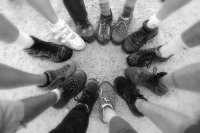
Feet Protection While Hiking
1. Keep your feet dry. Wet feet invite blisters and irritation. If they get wet from water or sweat, stop and change to dry socks if you have them.
2. Wear two layers of socks. The first should be a thin wick-away sock that wicks or removes moisture from the foot. The second should be a heavier sock that cushions the foot. Avoid cotton socks which keep moisture next to the skin.
3. Carry spare socks. If your socks get wet, you'll want spares. Fresh socks help cushion the feet and reduce foot fatigue.
4. Carry a first aid kit to treat blisters or foot injuries. The kit should include blister pads, antibiotic ointment, sterile gauze, band-aids, etc.
5. Promptly treat any signs of a beginning blister or chafed skin. The first signs are tenderness and a sense of burning, commonly known as a "hot spot." Use your first aid kit and blister treatments. The longer you ignore it, the worse it will get, to the point it can become almost impossible to keep hiking.
6. Choose the right boot. Select boots that fit properly and will provide the support and protection you need for the most difficult trail you're going to hike. Boots without proper support increase the risk of injury. Boots that are too tight pinch and chafe, causing blisters and pain.
7. Break in your boots before taking a long hike to avoid blisters and raw spots. New boots, particularly leather ones, take time to break in. Take several 1 to 2 hour hikes. You can soften leather using boot grease or leather conditioner






 Karim Maalouf
Karim Maalouf
